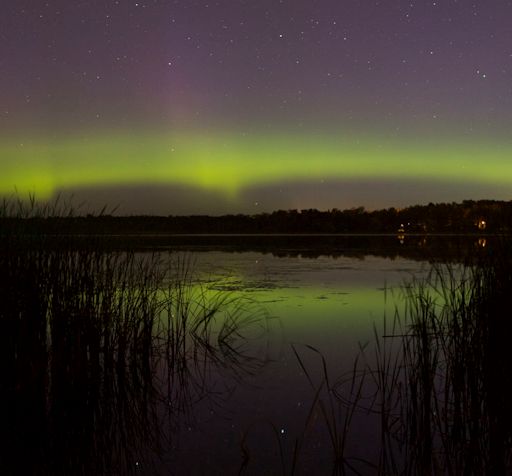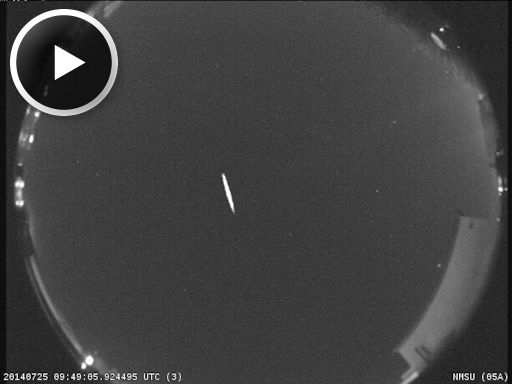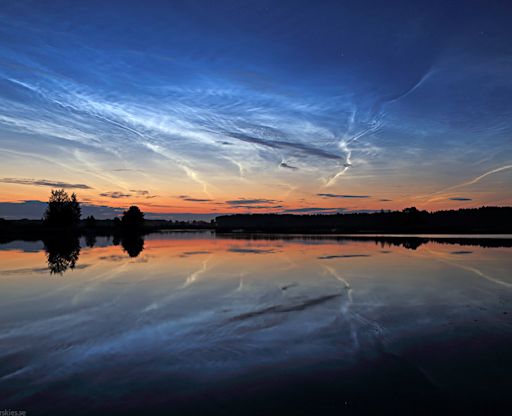When is the best time to see auroras? Where is the best place to go? And how do you photograph them? These questions and more are answered in a new book, Northern Lights - a Guide, by Pal Brekke & Fredrik Broms. | | |
SUNSPOT CORPSES: The return of old sunspots AR2107 and AR2108 from the farside of the sun has failed to elevate solar activity. The two formerly-active regions decayed during their two week absence and are now little more than "sunspot corpses." Forecasters expect the quiet sun to remain quiet throughout the weekend. Follow the action, or lack thereof, on Twitter @spaceweatherman.
AURORA SURPRISE: Auroras were *not* in the forecast this weekend. Nevertheless, "they're baaaaaaack," reports Bob Conzemius, who saw the Northern Lights on July 26th over Grand Rapids, Minnesota:

"It has been a pretty quiet summer in northern Minnesota for seeing auroras, so it was nice to see them again," says Conzemius. "I shot entirely within the city limits of Grand Rapids, starting from my front yard and ending at McKinney Lake as it was getting light at 4:00 AM CDT."
The source of this unexpected display was a fluctuation in the interplanetary magnetic field. The IMF tipped south, opening a crack in Earth's magnetospere. Solar wind poured in and ignited the auroras. Aurora alerts: text, voice
Realtime Aurora Photo Gallery
SOUTHERN DELTA AQUARIID METEOR SHOWER: Earth is entering a broad stream of debris from Comet 96P/Machholz, source of the annual Southern Delta Aquariid meteor shower. Forecasters expect as many as 20 meteors per hour to fly out of the constellation Aquarius on July 29-30 when the shower peaks. Already, NASA meteor cameras are detecting a smattering of fireballs--like this one over New Mexico on July 25th:

Although the shower favors the southern hemisphere, it is possible to see Southern Delta Aquariids from the north, too, as the video above shows. The best time to look is during the hours between local midnight and sunrise.
Got clouds? Try listening to the Southern Delta Aquariid meteor shower on Space Weather Radio. The audio stream is playing echoes from a forward-scatter meteor radar in Roswell, New Mexico. Also, NASA will stream the shower from an observing site at the Marshall Space Flight Center in Alabama. Live video begins on July 29th at 9:30 pm EDT.
Realtime Space Weather Photo Gallery
VEINS OF HEAVEN: The luminous tendrils of noctilucent clouds (NLCs) have been likened to "frozen lightning", slow-moving bolts of electric-blue that slowly zig-zag across the twilight sky during the months of Arctic summer. Last night photographer P-M Hedén witnessed a display over Hedesunda, Sweden, that suggested a different name. He calls them "veins of Heaven":

"I was really hoping for a good show because my children came along to watch," says Hedén. "We were not disappointed. From the beginning at 23:00 local time we saw noctilucent clouds all around the sky - amazing! Around 1 a.m. we had veins of Heaven both in the sky and reflected in the water."
Seeded by meteor smoke, are Earth's highest clouds. They glow electric-blue when sunlight strikes them more than 80 km above Earth's surface. The fine structure that resembles lightning and evokes "heavenly veins" is not fully understood. This is just one of many mysteries about NLCs that NASA has sent its AIM spacecraft to investigate.
The natural habitat of noctilucent clouds is the Arctic Circle. In recent years, however, they have spread to lower latitudes with sightings as far south as Utah and Colorado. This may yet happen in 2014. Observing tips: Look west 30 to 60 minutes after sunset when the Sun has dipped 6o to 16o below the horizon. If you see blue-white tendrils zig-zagging across the sky, you may have spotted a noctilucent cloud.
Realtime NLC Photo Gallery
Realtime Comet Photo Gallery
Every night, a network of NASA all-sky cameras scans the skies above the United States for meteoritic fireballs. Automated software maintained by NASA's Meteoroid Environment Office calculates their orbits, velocity, penetration depth in Earth's atmosphere and many other characteristics. Daily results are presented here on Spaceweather.com.
On Jul. 26, 2014, the network reported 19 fireballs.
( 19 sporadics)

In this diagram of the inner solar system, all of the fireball orbits intersect at a single point--Earth. The orbits are color-coded by velocity, from slow (red) to fast (blue). [Larger image] [movies]
Potentially Hazardous Asteroids (
PHAs) are space rocks larger than approximately 100m that can come closer to Earth than 0.05 AU. None of the known PHAs is on a collision course with our planet, although astronomers are finding
new ones all the time.
On July 26, 2014 there were 1493 potentially hazardous asteroids.
Notes: LD means "Lunar Distance." 1 LD = 384,401 km, the distance between Earth and the Moon. 1 LD also equals 0.00256 AU. MAG is the visual magnitude of the asteroid on the date of closest approach. | | The official U.S. government space weather bureau |
| | The first place to look for information about sundogs, pillars, rainbows and related phenomena. |
| | Researchers call it a "Hubble for the sun." SDO is the most advanced solar observatory ever. |
| | 3D views of the sun from NASA's Solar and Terrestrial Relations Observatory |
| | Realtime and archival images of the Sun from SOHO. |
| | from the NOAA Space Environment Center |
| | the underlying science of space weather |

